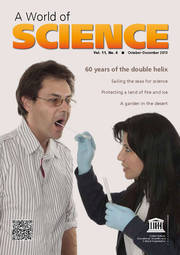A World of Science by theme: UNESCO’s World Network of Biosphere Reserves
- Protecting a land of fire and ice (2013, EN, ES, GER), on efforts by Cape Horn Biosphere Reserve in Chile to promote sustainable tourism, to protect one of the planet’s last wildernesses and create jobs
- A Garden in the Desert (2013, AR, EN), on a survey of Qatar which found that vegetation was recovering in parts of Qatar, even if desert rangelands and coastal areas remain in poor condition
- Rebirth of a Hunter (2013, EN), on how a hunter in Vietnam’s Cat Ba Biosphere Reserve hung up his rifle to become a forest ranger after realizing that his prey, the langur (a primate), was on the brink of extinction
- Putting a Price on Conservation (2012, EN, ES, FR), on how the Serra do Espinhaço Biosphere Reserve in Brazil is rewarding municipalities which protect biodiversity and ecosystems in the world’s most intensely mined biosphere reserve
- Striving for a Better Tomorrow in Mujib (2012, EN, ES, FR), on the new Mujib Biosphere Reserve in Jordan
- Forty Years of Field Laboratories in Sustainability (2011, EN, ES, FR, RU), tracing the history of UNESCO’s Man and the Biosphere Programme, which seeks to reconcile humanity with nature
- The Bushbruckridge Healers’ Path to Justice (2010, AR, EN, ES, FR, RU), on how traditional healers in the Kruger to Canyons Biosphere Reserve in South Africa will benefit from a revolution in environmental law due to be adopted by the United Nations
- Taking a Step Back (2009, AR, EN, ES, FR, RU), on why Malindi Watamu Biosphere Reserve in Kenya and Braunton Burrows–North Devon’s Biosphere Reserve in the UK have both concluded that retreat is the best policy in the face of sea-level rise
- Mayangna Knowledge Deep in the Heart of Mesoamerica (2008, AR, EN, ES, FR, RU), on this indigenous people’s struggle to protect one of the last extensive areas of Central American tropical rainforest, in the Boswas and Rio Platano Biosphere Reserves in Nicaragua and Honduras respectively
- Rhön’s Gastronomical Ambassadors (2008, EN, ES, FR, MLY, RU), on the Rhön Biosphere Reserve in Germany, which has turned the art of local gastronomy into a socio-economic success
- Saving the Remaining Wildlife in Darfur (2007, EN, ES, FR, RU), on a survey of the rapidly vanishing wildlife in Radom Biosphere Reserve, the victim of the proliferation of automatic weapons and refugees as a result of the armed conflict in Sudan
- Using the Sun to Quench their Thirst (2006, EN, ES, FR, RU), on a project in Omayed Biosphere Reserve in Egypt to desalinate groundwater at the population’s request
- Taking the Temperature of Mountains (2006, EN, ES, FR), on a project to monitor climate change and other forms of global change in selected biosphere reserves in mountainous regions
- The Pastoralists of Wadi Allaqi (2003, EN, FR), on the techniques pastoralists have developed in Wadi Allaqi Biosphere Reserve to survive in a region where it only rains every few years; introduces the research done by the UNESCO-Cousteau Ecotechnie Chair within the biosphere reserve
- Protecting Himalayan Biodiversity (2002, EN, FR), on a study planned for Nanda Devi Biosphere Reserve in India on the virtues of large-scale cultivation of medicinal and aromatic plants
See also Biodiversity and land management

